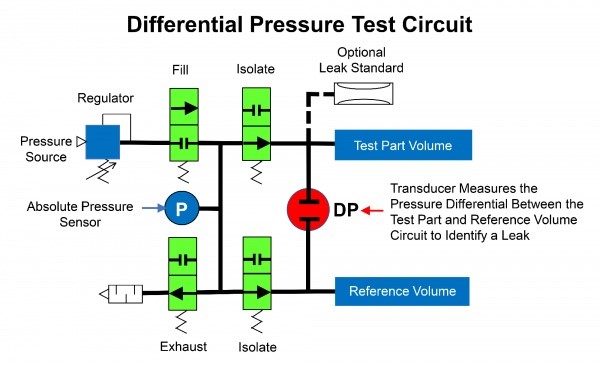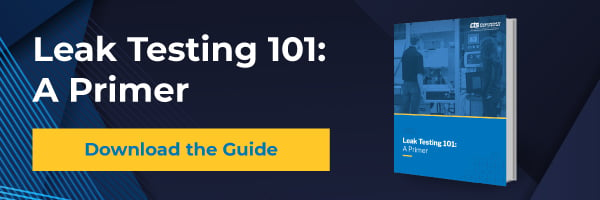What is a differential pressure decay leak test and when is it used?
Pressure decay leak testing is sensitive to very small leaks, economical, and reasonably simple to implement. But to ensure a reliable and repeatable test result, it must be calibrated to an accurate leak standard, defined by volumetric flow, test pressure, and the test volume of the part.
With differential pressure decay leak testing, we achieve this calibration by using a reference volume. The test detects a leak by measuring a pressure change between a reference volume of air and the test part volume.
This delivers a highly accurate test that is protected against sudden atmospheric pressure changes and able to detect very small leaks. Pressure loss measurement resolution is 0.000001 psi and leak rate resolution is 0.00005 sccm.
Consider the example of a photo finish in a race. If you are standing trackside at the finish line, a photo will be blurred by the motion of the cars. But if you were moving alongside the cars at the same speed, it is the cars that will be crisp in the photo and the background that will be blurred. An absolute pressure decay leak test is like standing still, while the differential test has your camera moving at the same speed as the cars. This results in a crisper image that leaves no doubt which car crossed the finish line first.
How a differential pressure decay test works
For a differential pressure decay test, the test part and a reference volume are filled to a specified test pressure. Both are then shut off from the supply pressure. The test pressure stabilizes, and the reference air isolation valves are closed. A differential pressure transducer measures for any change in pressure between the test part volume and the non-leaking reference volume during the programmed test time.

At the conclusion of the test, the instrument reports the change in the differential pressure between the test part and its reference volume. If the differential pressure decay is within the “target pressure window,” the part passes the leak test. If outside the target limits, the part fails the leak test and is rejected.
When do we use differential pressure decay?
A differential pressure decay leak test is ideally suited to the following test scenarios:
- Testing parts above 30 psig, such as fuel delivery system components that must endure high pressures. Higher test pressures can result in a greater thermal effect that can warm the part and skew test results unless a stabilization phase or some other form of compensation is added to the test cycle. A differential approach helps to reduce the thermal effect by comparing two volumes affected by the same pressure induced thermal event.
- Large non-expanding parts (final assembly engines and transmissions), for improved test repeatability using a high resolution transducer.
- Parts with very small pressure loss (think consumer electronics), for increased resolution (test sensitivity).
- In any circumstance where the goal is to improve test repeatability or decrease cycle time, especially with small leak rates (such as 0.1 – 3 scc/m).
- For comparing the leak rate of two production parts (instead of a production part to a reference volume).
Differential pressure decay testing for sealed devices
Differential pressure is also a safe and effective way to leak test small sealed devices that must meet or surpass the IP67 standard, such as IIoT sensors and other electronics, that have no means of creating a test pressure inside. Instead, this is “outside-in” leak testing – measuring for any indication that pressurized air is forcing itself through an undesired leak path into the test part.
The best approach here is to reference an actual production part that is a known good part. Also, each chamber must be designed to allow as little free air around the part as possible and ensure all points of potential leakage are exposed.
Is differential testing the right choice for your application? Contact us to learn more about differential decay leak testing and how we can help you design reliable test chambers and reference parts.
If you want to learn more about the nuances of leak testing, download our latest guide, Leak Testing 101: A Primer, or contact us with any questions you might have.



